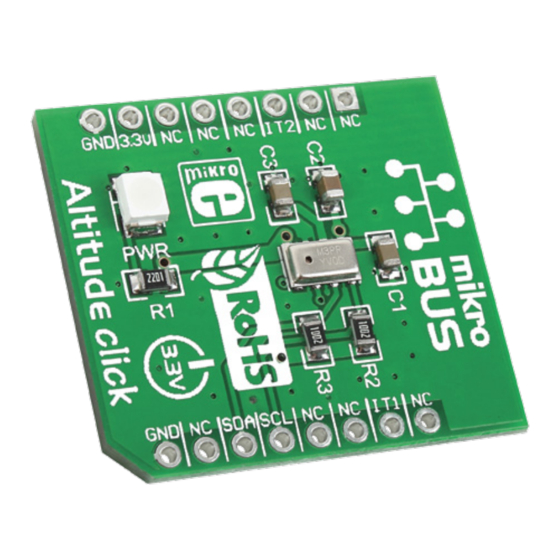
Advertisement
click
Altitude
1. Introduction
Altitude click
is an accessory board in
™
mikroBUS
form factor. It's a compact
™
and easy solution for adding altimeter
to your design. It features
MPL3115A2
precision
pressure/temperature
sensor
which also provides altitude data. Altitude
click
communicates with the target
™
board microcontroller via
mikroBUS
™
(SCL, SDA), INT and CS lines. The board is
designed to use 3.3V power supply only.
LED diode (GREEN) indicates the presence
of power supply.
Before using your click
board, make sure
™
to solder 1x8 male headers to both left
and right side of the board. Two 1x8 male
headers are included with the board in
the package.
2
Turn the board upside down so that
bottom side is facing you upwards.
Place shorter pins of the header into the
appropriate soldering pads.
I
C
2
2. Soldering the headers
3
Turn the board upward again. Make sure
to align the headers so that they are
perpendicular to the board, then solder the
pins carefully.
3. Plugging the board in
Once you have soldered the headers your
board is ready to be placed into desired
mikroBUS
™
socket. Make sure to align the
cut in the lower-right part of the board
with the markings on the silkscreen at
the mikroBUS
socket. If all of the pins are
™
aligned correctly, push the board all
1
4. Essential features
Altitude click
employs a MEMS pressure sensor to provide
accurate pressure/altitude (20-bit) and
temperature (12-bit) data. Resolution is
down to 30 cm (1.5 Pa). The
is capable of processing internal data
automatically with data acquisition and
compensation. This makes altitude sensor
an ideal choice for smart phones/tablets,
personal electronics altimetry, GPS systems,
weather station equipment and many more.
the way into the socket.
with it's
MPL3115A2
IC
™
MPL3115A2
click
BOARD
www.mikroe.com
Altitude click Manual
ver. 1.00
0 100000 024751
Advertisement
Table of Contents

Summary of Contents for mikroElektronika Altitude click
- Page 1 ™ board microcontroller via mikroBUS with the markings on the silkscreen at ™ Altitude click Manual (SCL, SDA), INT and CS lines. The board is the mikroBUS socket. If all of the pins are ™ ver. 1.00 designed to use 3.3V power supply only.
- Page 2 MikroElektronika assumes no responsibility or liability for any errors or inaccuracies that may appear in the present document. Specification and information contained in the present schematic are subject to change at any time without notice. Copyright © 2013 MikroElektronika. All rights reserved.















Need help?
Do you have a question about the Altitude click and is the answer not in the manual?
Questions and answers